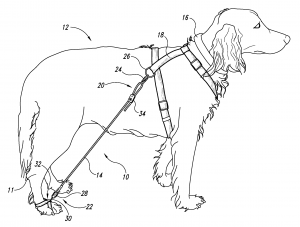 On Monday, March 5th, the Court of Appeals for the Federal Circuit heard oral arguments in In Re Verhoef, a case stemming from a patent application rejected by the U.S. Patent and Trademark Office for issues over improper inventorship under 35 U.S.C. § 102(f). The appeal to the Federal Circuit comes after the Patent Trial and Appeal Board (PTAB) affirmed the rejection of claims covering a healthcare product for dogs after deciding that the inventor’s incorporation of a suggestion proffered by a veterinarian entitled the vet to joint inventorship.
On Monday, March 5th, the Court of Appeals for the Federal Circuit heard oral arguments in In Re Verhoef, a case stemming from a patent application rejected by the U.S. Patent and Trademark Office for issues over improper inventorship under 35 U.S.C. § 102(f). The appeal to the Federal Circuit comes after the Patent Trial and Appeal Board (PTAB) affirmed the rejection of claims covering a healthcare product for dogs after deciding that the inventor’s incorporation of a suggestion proffered by a veterinarian entitled the vet to joint inventorship.
 The case is focused on the patentability of U.S. Patent Application No. 20130152873, entitled Dog Mobility Device and claiming priority to a previous application filed in December 2011. It discloses a dog mobility device including an elastic cord connectable to a dog harness and a paw loop connectable to the lower rearward end portion of the elastic cord and configured to engage one of the dog’s paws. The resulting invention assists with both the forward movement of a dog’s hind legs and the upward movement of its toes to aid dogs suffering from canine degenerative myelopathy, which causes hind leg weakness.
The case is focused on the patentability of U.S. Patent Application No. 20130152873, entitled Dog Mobility Device and claiming priority to a previous application filed in December 2011. It discloses a dog mobility device including an elastic cord connectable to a dog harness and a paw loop connectable to the lower rearward end portion of the elastic cord and configured to engage one of the dog’s paws. The resulting invention assists with both the forward movement of a dog’s hind legs and the upward movement of its toes to aid dogs suffering from canine degenerative myelopathy, which causes hind leg weakness.
The ‘873 patent application lists Jeff VerHoef as the sole inventor. In a decision on ex parte appeal issued by the PTAB this February, the PTAB sided with the USPTO examiner who declared all five claims of the ‘873 patent application invalid under Section 102(f). A declaration filed by VerHoef with the ‘873 patent application indicated that he formed the idea of a mobility device for canines which improved upon the prior art Biko Brace. VerHoef’s own dog suffered from myelopathy and during a therapy session with a veterinarian, VerHoef opined that the Biko Brace could work better if connected to the dog’s toes instead of the dog’s leg above the paw. The veterinarian suggested the configuration of a “figure 8” loop that fit around the toes to help with the upward mobility of the toes. The PTAB found that the vet’s contribution of this figure 8 toe loop construction, “a critical part of the claimed subject matter,” did not make VerHoef the sole inventor despite the assertion that VerHoef “maintained complete intellectual domination and control over the inventive process” leading up to the ‘873 patent application.
In a prior abandoned patent application, VerHoef listed himself as joint inventor of the dog mobility device with Dr. Lamb, the veterinarian making the suggestion; this joint venture failed and then each party tried to file competing patent applications. This was all done at a time when VerHoef was not well acquainted with patent law according to Thomas Loop, patent attorney at Loop IP Law representing VerHoef in the case. “All inventors take limitations and elements from others, that’s the essence of inventions,” Loop argued to the Federal Circuit panel of Circuit Judges Pauline Newman, Haldane Robert Mayer and Alan Lourie. “[VerHoef] had the entire reduction to practice of the invention… she blurted out an idea, and he adopted it. That’s what happened here.” Although VerHoef agreed that Dr. Lamb did provide the suggestion, Loop argued that this suggestion did not elevate the veterinarian to the level of inventor.
In asking the Federal Circuit to declare VerHoef as the sole and original inventor of the dog mobility device, Loop noted that the PTAB’s decision reflected a lack of clarity on the law governing inventorship. “The question before the court is, what is an inventor?” Loop said. He cited to Morse v. Porter, a 1965 case decided by the Board of Patent Appeals and Interferences (BPAI), the predecessor of the PTAB, noting that case established that an inventor may adopt ideas or suggestions from others and remain the sole inventor “so long as the inventor maintains intellectual domination of the work of making the invention,” even when the suggestion proves crucial to the resulting invention. Morse v. Porter is a case which is cited in the Manual of Patent Examining Procedure (MPEP) in the section regarding the proper determination of inventorship. Although the case is not binding on the Federal Circuit, Loop suggested that it would serve as safe harbor for inventors, an important consideration from a public policy standpoint. “To deprive Mr. VerHoef of his invention has a chilling effect on the free flow of ideas,” Loop said. “We want inventors, prospective inventors, to solicit ideas from others. You want the free flow of ideas.”
It was the USPTO’s view, however, that this was a clear case of joint inventorship according to Meredith Schoenfeld, representing the Patent Office at the Federal Circuit. “Based on the earlier application that was filed jointly and two applications which were filed on the same date, the PTO made the determination that the correct inventorship was not stated on the patent application,” Schoenfeld said; Lamb had filed a patent application listing herself as the sole inventor, but that application was abandoned.
In questioning Schoenfeld, Judge Newman expressed some confusion as to what basis the Patent Office had for rejecting the patent application over an inventorship issue, noting that this case did not stem from any intervention or derivation proceedings. Schoenfeld argued that the USPTO based the invalidation upon the facts proffered by VerHoef in the declaration and indicated that he had remedies available, such as adding Dr. Lamb as a joint inventor in the application. Still, Judge Newman had questions as to whether the Patent Office had conducted the appropriate proceeding for invalidating the patent on this inventorship issue. “It’s really curious to me to see this kind of total rejection of the application because there is a legitimate question about inventorship instead of all of the other ways over the decades that have tried to figure out inventorship,” Judge Newman said. In supporting the USPTO’s actions, Schoenfeld cited to Pannu v. Iolab Corporation, a Federal Circuit case decided in 1998 which found that the only requirement to be considered a joint inventor was a significant contribution to the conception or reduction to practice of the invention, or any contribution to the claimed invention which is not insignificant in nature.

![[IPWatchdog Logo]](https://ipwatchdog.com/wp-content/themes/IPWatchdog%20-%202023/assets/images/temp/logo-small@2x.png)

![[Advertisement]](https://ipwatchdog.com/wp-content/uploads/2024/04/UnitedLex-May-2-2024-sidebar-700x500-1.jpg)
![[Advertisement]](https://ipwatchdog.com/wp-content/uploads/2024/04/Patent-Litigation-Masters-2024-sidebar-700x500-1.jpg)

![[Advertisement]](https://ipwatchdog.com/wp-content/uploads/2021/12/WEBINAR-336-x-280-px.png)
![[Advertisement]](https://ipwatchdog.com/wp-content/uploads/2021/12/2021-Patent-Practice-on-Demand-recorded-Feb-2021-336-x-280.jpg)
![[Advertisement]](https://ipwatchdog.com/wp-content/uploads/2021/12/Ad-4-The-Invent-Patent-System™.png)






Join the Discussion
5 comments so far.
Anon
March 14, 2018 09:15 pm“ Post AIA, what is their remedy, if anything.”
Who is the “their” in your question?
For your second question, why would you suppose that an inventor who believes himself to be a sole inventor – without more – be something that should be complained about?
Your hypos need more context.
Edward Heller
March 14, 2018 06:51 pmanon, the PTO does not believe that the named inventor is in fact the sole inventor. Post AIA, what is their remedy, if anything.
Next, consider an accused infringer? Can they even complain about inventorship if the named inventor actually believes himself to be the sole inventor?
Judge Rich’s Ghost
March 13, 2018 02:00 pmListen to the oral argument here. It’s a classic example of an attorney not knowing the law, not knowing how to argue the appeal, and not knowing what the role of the Federal Circuit is. It’s a terrible argument.
Anon
March 13, 2018 01:48 pmWhat is whose remedy?
In a fact pattern such as presented here, your post is unclear – which are you asking about: the not naming of someone who should have been named, wherein two different players and their respective remedies may be at issue: the individual so named trying to keep it that way, or the unnamed person trying to have his contribution recognized?
Every question may have to come with the perspective identified.
Edward Heller
March 13, 2018 11:24 amHow is this going to work post AIA with 102(f) repealed? A person believing himself to be the sole inventor declares himself to be the sole inventor but the patent office disagrees. What is their remedy?